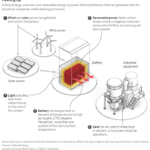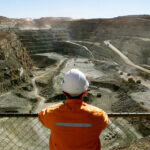Energy News Beat
Industrial companies are searching for ways to make steel, cement and chemicals without burning fossil fuels. Some of the world’s biggest investors are betting a fast-developing battery that stores heat can solve the problem.
headline a group of financiers pouring hundreds of millions of dollars into startups making heat batteries. Also called thermal batteries, they use renewable energy to heat up blocks, rocks or molten salt. That heat is released on demand to power industrial processes.
Using electricity to generate heat is nothing new. That is how toasters work. The difference is that these toasters are roughly the size of shipping containers and release steam as hot as 2,750 degrees Fahrenheit, more than a quarter of the sun’s surface temperature. The trick is keeping the batteries hot until the heat is needed.
Heating Up
Antora Energy uses low-cost renewable energy to power thermal batteries that can generate heat for industrial companies while slashing emissions.
Industrial heat accounts for about a fifth of global energy use and roughly 10% of greenhouse-gas emissions. Hundreds of industrial processes including steelmaking burn fossil fuels to generate the high heat they need.
Large manufacturers are looking at everything from green hydrogen to nuclear fusion to replace fossil fuels and cut emissions. Knowing how hard this can be, they are also looking at removing carbon directly from the atmosphere to offset emissions that can’t be eliminated.
CEO Andrew Ponec, center, and his co-founders studied several possible materials for heat batteries before landing on carbon blocks.
The latest bet on heat batteries is a $150 million investment round for a California startup called Antora Energy from backers including BlackRock, renewable energy giant NextEra Energy and Bill Gates’s Breakthrough Energy Ventures.
Antora uses carbon blocks that glow red like a toaster coil or an electric stove when heated up. Antora’s batteries are unusual because heat is transferred using the light from the hot blocks, eliminating the need for air or fluid to transfer energy and making the product cheaper.
“There’s not some crazy, magic technology going on here,” Andrew Ponec, Antora’s chief executive, said in an interview. “It’s something that’s very intuitive.”
Antora has been testing its heat battery system with a pilot project near Fresno, Calif.
Pipes and process lines would be used to carry heat from the battery to industrial facilities.
Traditional batteries store and release renewable power by moving lithium ions through a liquid from the cathode to the anode, and back again. They are great when space is at a premium, as is the case inside electric cars. But they can explode or catch fire when they overheat. They are also relatively expensive and typically can only discharge energy for several hours, limiting their applications in heavy industry.
Heat-battery startups say they can cheaply store days worth of renewable energy with a different approach. To charge, Antora’s batteries run renewable electricity through an element comparable to a toaster coil to warm up the blocks. The company settled on the carbon blocks because they can store heat for a long time, and actually get better at storing energy as they get hotter. That allows them to maintain high temperatures for long periods when heat or steam needs to be used.
Other startups are making similar claims, driving significant funding into the industry for the first time. Cheap wind and solar power now make heat batteries cost competitive with heat made from burning fossil fuels like natural gas, analysts say. Tax credits from the 2022 law known as the Inflation Reduction Act are accelerating the momentum.
Many industrial companies had planned to use hydrogen made from renewable power to generate heat, but high production costs and project delays are making that less attractive. That has led companies to pursue other solutions such as heat batteries.
Heat batteries may be poised to leapfrog hydrogen for many industrial uses. They can be deployed at large scale in the next few years and keep costs down by using abundant raw materials, investors say. They are one of several technologies being unlocked by the drop in renewable-electricity prices over the past decade.
Falling prices of solar power have made Antora’s heat batteries cost competitive with burning fossil fuels.
“Antora represents the next era for wind and solar,” said Meghan Sharp, global head of Decarbonization Partners, a joint venture between BlackRock and Singapore’s Temasek Holdings that invests in clean-energy companies and led the Antora investment round. “They’re bringing renewables to industry.”
Founded in 2018, Antora turned on its first battery for a customer in September near Fresno, Calif., and opened its first manufacturing facility in San Jose, Calif., last year. The company expects to use the new funding to install larger projects for customers in the Midwest, accelerate battery production and increase hiring.
In the next few years, it hopes to start producing systems that can turn the light emanating from the blocks into renewable electricity so that the batteries can serve double duty, releasing heat and power.
Antora is also talking to an Energy Department office that loans money to rapidly growing clean-energy companies about potential funding, Ponec said. Much of the company’s initial funding came from the state of California and an Energy Department agency that funds initial research into promising ideas that are too premature for private investment.
A competitor called Rondo Energy that uses clay bricks instead of carbon blocks recently raised $60 million from backers including Rio Tinto, Aramco and Microsoft and installed its first commercial battery for a biofuel company in California last year. Also backed by Breakthrough, Rondo is working with Asian building-materials giant Siam Cement Group to open a megafactory.
“We’ve been building the company like crazy to respond to demand,” Rondo CEO John O’Donnell said.
The post The New Hot Climate Investment Is Heat Itself appeared first on Energy News Beat.








